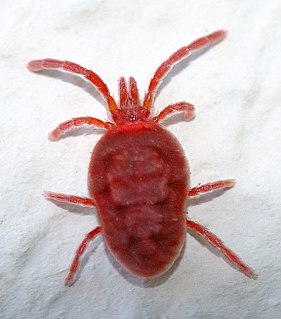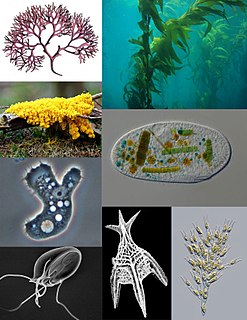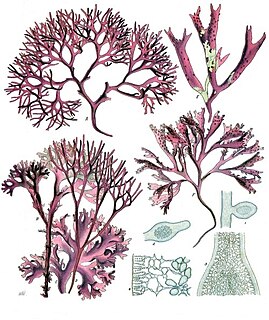
Algae is an informal term for a large and diverse group of photosynthetic eukaryotic organisms. It is a polyphyletic grouping that includes species from multiple distinct clades. Included organisms range from unicellular microalgae, such as Chlorella, Prototheca and the diatoms, to multicellular forms, such as the giant kelp, a large brown alga which may grow up to 50 metres (160 ft) in length. Most are aquatic and autotrophic and lack many of the distinct cell and tissue types, such as stomata, xylem and phloem, which are found in land plants. The largest and most complex marine algae are called seaweeds, while the most complex freshwater forms are the Charophyta, a division of green algae which includes, for example, Spirogyra and stoneworts.

Chromista is a biological kingdom consisting of single-celled and multicellular eukaryotic species that share similar features in their photosynthetic organelles (plastids). It includes all protists whose plastids contain chlorophyll c, such as some algae, diatoms, oomycetes, and protozoans. It is probably a polyphyletic group whose members independently arose as separate evolutionary group from the common ancestor of all eukaryotes. As it is assumed the last common ancestor already possessed chloroplasts of red algal origin, the non-photosynthetic forms evolved from ancestors able to perform photosynthesis. Their plastids are surrounded by four membranes, and are believed to have been acquired from some red algae.

In biology, a biological life cycle is a series of changes in form that an organism undergoes, returning to the starting state. "The concept is closely related to those of the life history, development and ontogeny, but differs from them in stressing renewal." Transitions of form may involve growth, asexual reproduction, or sexual reproduction.
A coenocyte is a multinucleate cell which can result from multiple nuclear divisions without their accompanying cytokinesis, in contrast to a syncytium, which results from cellular aggregation followed by dissolution of the cell membranes inside the mass. The word syncytium in animal embryology is used to refer to the coenocytic blastoderm of invertebrates. A coenocytic cell is referred to as a coenobium, and most coenobia are composed of a distinct number of cells, often as a multiple of two.
The Syndiniales are an order of early branching dinoflagellates, found as parasites of crustaceans, fish, algae, cnidarians, and protists. The trophic form is often multinucleate, and ultimately divides to form motile spores, which have two flagella in typical dinoflagellate arrangement. They lack a theca and chloroplasts, and unlike all other orders, the nucleus is never a dinokaryon. A well-studied example is Amoebophrya, which is a parasite of other dinoflagellates and may play a part in ending red tides. Several MALV groups have been assigned to Syndiniales; recent studies, however, show paraphyly of MALVs suggesting that only those groups that branch as sister to dinokaryotes belong to Syndiniales.

The hard clam, also known as a quahog, round clam or hard-shellclam, is an edible marine bivalve mollusk that is native to the eastern shores of North America and Central America from Prince Edward Island to the Yucatán Peninsula. It is one of many unrelated edible bivalves that in the United States are frequently referred to simply as clams, as in the expression "clam digging". Older literature sources may use the systematic name Venus mercenaria; this species is in the family Veneridae, the venus clams.

The Acariformes, also known as the Actinotrichida, are the most diverse of the two superorders of mites. Over 32,000 described species are found in 351 families, and an estimated total of 440,000 to 929,000 species occur, including undescribed species.
In 1909, the entomologist Carlo Emery noted that social parasites among insects tend to be parasites of species or genera to which they are closely related. Over time, this pattern has been recognized in many additional cases, and generalized to what is now known as Emery's rule. The pattern is best known for various taxa of Hymenoptera. For example, the social wasp Dolichovespula adulterina parasitizes other members of its genus such as Dolichovespula norwegica and Dolichovespula arenaria. Emery's rule is also applicable to members of other kingdoms such as fungi, red algae, and mistletoe. The significance and general relevance of this pattern are still a matter of some debate, as a great many exceptions exist, though a common explanation for the phenomenon when it occurs is that the parasites may have started as facultative parasites within the host species itself, but later became reproductively isolated and split off from the ancestral species, a form of sympatric speciation.

A parasitic plant is a plant that derives some or all of its nutritional requirement from another living plant. They make up about 1% of angiosperms and are found in almost every biome. All parasitic plants have modified roots, called haustoria, which penetrate the host plant, connecting them to the conductive system – either the xylem, the phloem, or both. For example, plants like Striga or Rhinanthus connect only to the xylem, via xylem bridges (xylem-feeding). Alternately, plants like Cuscuta and Orobanche connect only to the phloem of the host (phloem-feeding). This provides them with the ability to extract water and nutrients from the host. Parasitic plants are classified depending as to the location where the parasitic plant latches onto the host and the amount of nutrients it requires. Some parasitic plants are able to locate their host plants by detecting chemicals in the air or soil given off by host shoots or roots, respectively. About 4,500 species of parasitic plant in approximately 20 families of flowering plants are known.
An apicoplast is a derived non-photosynthetic plastid found in most Apicomplexa, including Toxoplasma gondii, Plasmodium falciparum and other Plasmodium spp., but not in others such as Cryptosporidium. It originated from algae through secondary endosymbiosis. The apicoplast is surrounded by four membranes within the outermost part of the endomembrane system. The apicoplast hosts important metabolic pathways like fatty acid synthesis, isoprenoid precursor synthesis and parts of the heme biosynthetic pathway

The term fish kill, known also as fish die-off, refers to a localized die-off of fish populations which may also be associated with more generalized mortality of aquatic life. The most common cause is reduced oxygen in the water, which in turn may be due to factors such as drought, algae bloom, overpopulation, or a sustained increase in water temperature. Infectious diseases and parasites can also lead to fish kill. Toxicity is a real but far less common cause of fish kill.
Heterotrophic nutrition is a type of nutrition in which organisms depend upon other organisms for food to survive. Heterotrophic organisms have to take in all the organic substances they need to survive.

Protozoan infections are parasitic diseases caused by organisms formerly classified in the Kingdom Protozoa. They are usually contracted by either an insect vector or by contact with an infected substance or surface and include organisms that are now classified in the supergroups Excavata, Amoebozoa, SAR, and Archaeplastida.
In algal anatomy, a pit connection is a hole in the septum between two algal cells, and is found only in the red algae − specifically, all orders except the Porphyridiales and haploid Bangiales. They are often stoppered with proteinaceous "pit plugs". By contrast, many fungi contain septal pores − an unrelated phenomenon.

A protist is any eukaryotic organism that is not an animal, plant, or fungus. While it is likely that protists share a common ancestor, the exclusion of other eukaryotes means that protists do not form a natural group, or clade. So some protists may be more closely related to animals, plants, or fungi than they are to other protists; however, like algae, invertebrates, or protozoans, the grouping is used for convenience. The study of protists is termed protistology.

Red algae, or Rhodophyta, are one of the oldest groups of eukaryotic algae. The Rhodophyta also comprises one of the largest phyla of algae, containing over 7,000 currently recognized species with taxonomic revisions ongoing. The majority of species (6,793) are found in the Florideophyceae (class), and mostly consist of multicellular, marine algae, including many notable seaweeds. Red algae are abundant in marine habitats but are relatively rare in freshwaters. Approximately 5% of the red algae occur in freshwater environments with greater concentrations found in warmer areas. Except for two coastal cave dwelling species in the asexual class Cyanidiophyceae, there are no terrestrial species, which may be due to an evolutionary bottleneck where the last common ancestor lost about 25% of its core genes and much of its evolutionary plasticity.
Chromera velia, also known as a "chromerid", is a unicellular photosynthetic organism in the superphylum Alveolata. It is of interest in the study of apicomplexan parasites, specifically their evolution and accordingly, their unique vulnerabilities to drugs.

Coral reef fish are fish which live amongst or in close relation to coral reefs. Coral reefs form complex ecosystems with tremendous biodiversity. Among the myriad inhabitants, the fish stand out as colourful and interesting to watch. Hundreds of species can exist in a small area of a healthy reef, many of them hidden or well camouflaged. Reef fish have developed many ingenious specialisations adapted to survival on the reefs.

Pugettia producta, known as the northern kelp crab or shield-backed kelp crab, is a species of crab in the family Epialtidae.

Floridean starch is a type of a storage glucan found in glaucophytes and in red algae, in which it is usually the primary sink for fixed carbon from photosynthesis. It is found in grains or granules in the cell's cytoplasm and is composed of an α-linked glucose polymer with a degree of branching intermediate between amylopectin and glycogen, though more similar to the former. The polymers that make up floridean starch are sometimes referred to as "semi-amylopectin".












